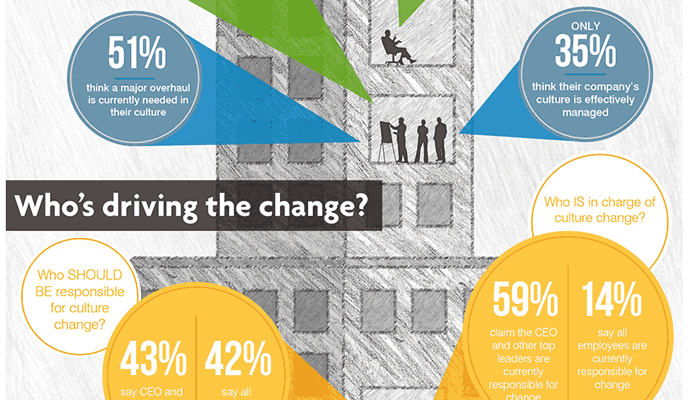Getting to the Critical Few Behaviors That Can Drive Cultural Change
Encouraging a small number of actions can help an organization achieve its strategic and operational objectives.
Focusing on a “critical few” behaviors is one of the fundamental tenets of working effectively with organizational culture. Sometimes called keystone behaviors, these are patterns of acting that are tangible, repeatable, observable, and measurable, and will contribute to achieving an organization’s strategic and operational objectives. The behaviors are critical because they will have a significant impact on business performance when exhibited by large numbers of people; they are few because people can really only remember and change three to five key behaviors at one time.
In the work done by Katzenbach Center consultants around the world, we have seen how a focus on a critical few behaviors helps bring about changes that contribute to meaningful business outcomes, whether it is a medical devices manufacturer tallying 10 straight quarters of revenue growth or a technology firm saving US$100 million a year in warranty costs.
A New York Times article by Charles Duhigg, author of Smarter, Faster, Better: The Secrets of Being Productive in Life and Business (Random House, 2016), provides a simple example of critical few behaviors in a nonbusiness environment. When Duhigg’s family members tried to solve the problem of not getting to eat dinner together often enough, they applied a classic Toyota Production System technique of “the Five Whys” — framing the problem, then repeatedly asking “Why?” to uncover root causes. In Duhigg’s case, the root cause turned out to be that the family was always late getting out the door in the morning because it took so long for the kids to get dressed, which triggered a cascade of delays throughout the day. The solution the family developed — laying out clothes the night before — allowed them to have calmer mornings, leave for work earlier, get work done earlier in the day, leave work on time, and get home to have dinner as a family more often.
Choosing and laying out outfits the night before is a perfect example of a keystone behavior. It is actionable, highly visible, measurable, and able to deliver short-term results. Most important, adopting the behavior has a meaningful impact on the ultimate goal.
Choosing and laying out outfits the night before is a perfect example of a keystone behavior.
Not all our business problems can be solved through such simple actions. But defining and selecting the critical few behaviors is an important first step. And rather than repeatedly asking the simple question, “Why?” you can get there by following a four-step process.
Know what you’re trying to accomplish. It’s vital to identify the area or issue in which you are trying to make a difference. For an organization, this often means aligning with the strategic priorities or, sometimes, the goals of a critical enterprise-wide transformation effort. Examples could include reducing injuries in a plant environment, or increasing IT system reliability and resiliency. Defining the ultimate goal will help you to understand what the behaviors should be aimed toward.
Define the behaviors that will contribute to the goals. A behavior is a habitual way of acting that is considered the norm or expectation — it is not a one-time action, a policy change, an outcome, or a mind-set/attitude. To reduce injuries in a plant, a company may focus on maintaining a safe work environment. Declaring a plant “clean-up day” is an example of a one-time action. By contrast, an appropriate habitual behavior could be getting employees to take ownership to maintain the safety of the shop’s workspace, which would include proper waste disposal and the elimination of tripping hazards. You can brainstorm behaviors that will contribute to the goals you’ve defined by asking, “In a future state in which we’ve achieved the goals, what would people actually do (or do differently)?” Then review your brainstormed list to make sure all the behaviors are specific, repeatable, and preferably applicable to everyone in the organization — at all levels and roles.
Prioritize the critical few behaviors. A common way to do this is to plot the behaviors using the axes of implementation and impact.
Implementation criteria include:
- Actionability: Are people able to perform the behavior?
- Degree of visibility: Can people see others performing the behavior?
- Measurability: Can you measure (preferably objectively) whether people are performing the behavior?
- Speed of results: Can people performing the behavior deliver results in the short term?
- Ease of implementation: Given the current organizational environment, how easy/difficult will it be for people to perform the new behavior?
There is only one impact criterion: Will people performing the behavior make a difference in your efforts to achieve your defined goals?
In prioritizing the critical few, impact is exponentially more important than the implementation criteria. Ultimately, the best choices for the critical few behaviors are those that will move the needle furthest on the strategic and operational objectives of your organization.
Validate your choices by getting input from both formal and informal leaders. You might consider using a voting process — it could be an electronic voting tool or something as old-school as a show of hands — to gather formal leaders’ views and prioritize down to the critical few. Then get input from your organization’s “authentic informal leaders” (AILs), those people in your organization who have not been endowed with formal authority yet exhibit the informal leadership strengths that can influence their peers or teams. (My colleague Reid Carpenter has helpfully described how to find and engage AILs.)
When establishing the critical few with AILs, it’s usually best to start by discussing the strategic and operational goals, then presenting a smaller subset of behaviors for AILs’ reactions. The key is to generate input on which behaviors resonate, and share stories of how they would (or already do!) exhibit these behaviors. If AILs are excited about a particular behavior and the impact it could have, it’s a good bet that it is one of the critical few. Armed with this insight, go back to your formal leaders to finalize the plan of action.
Now the journey of driving, reinforcing, and measuring those behaviors throughout the organization can begin. We’ll discuss this topic in more detail in an upcoming blog post. But in a nutshell, as the organization embarks on these efforts, it is important to choose both formal and informal methods to spread the behaviors, and to ensure that formal aspects of the organization (such as performance management, awards, and compensation) are aligned with the critical few behaviors. Leaders should also choose a few key metrics to evaluate the adoption of the behaviors and their impact on strategic and operational goals.
Of course, driving change through a critical few behaviors won’t be as easy for a complex corporation as it is for a family. In Duhigg’s case, the parents could dictate the new behavior and exert a large amount of control over whether it was followed. Still, it is possible to leverage a few behaviors into tangible progress for your organization. And it can be incredibly satisfying to help your organization’s people contribute more tangibly to the strategic and operational goals — almost as satisfying as having dinner with your family.






